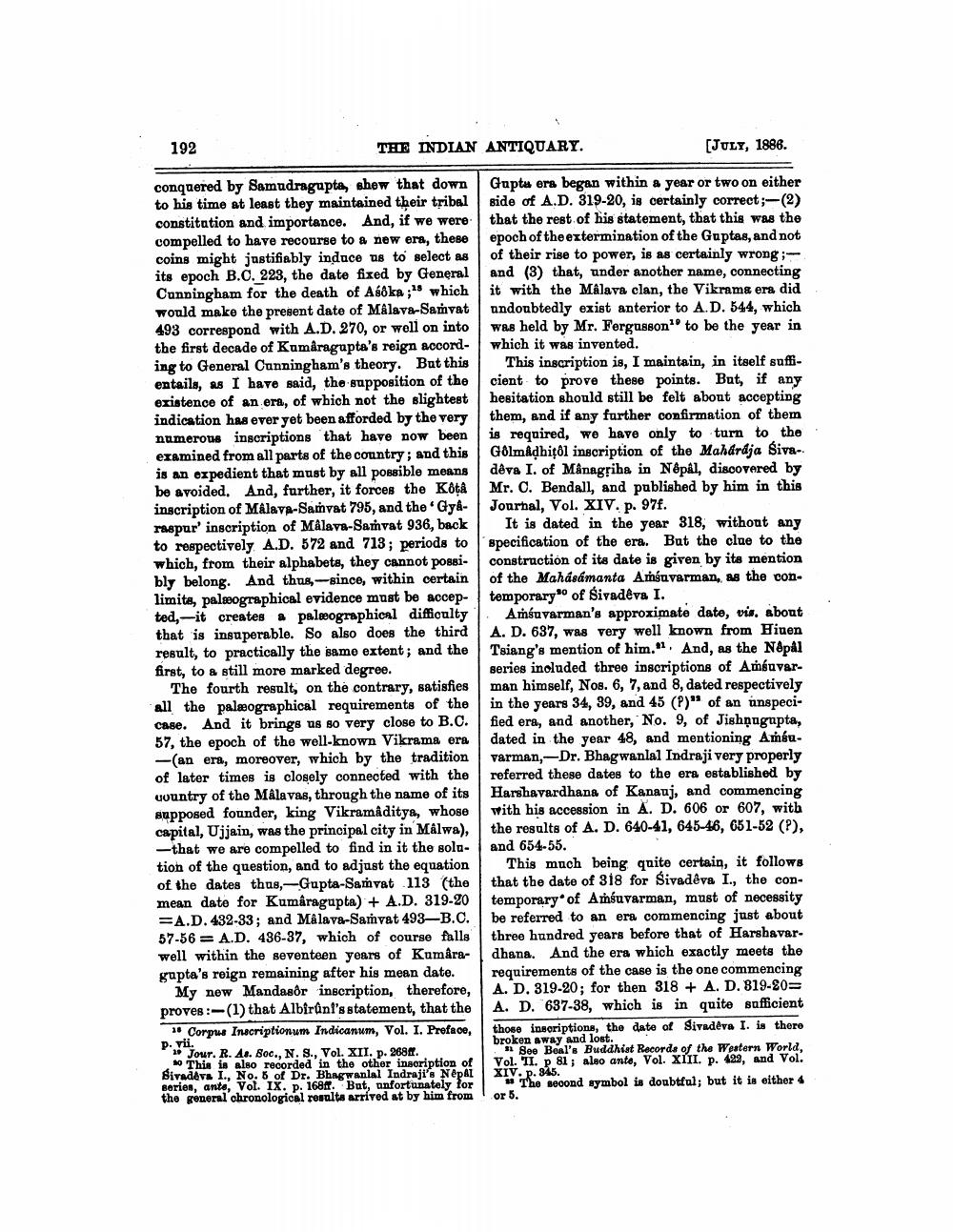________________
192
THE INDIAN ANTIQUARY.
[JULY, 1886.
conquered by Samudragupta, shew that down to his time at least they maintained their tribal constitution and importance. And, if we were compelled to have recourse to a new era, these coins might justifiably induce us to select as its epoch B.O. 223, the date fixed by General Cunningham for the death of Asoka ;" which would make the present date of Mâlava-Samvat 493 correspond with A.D. 270, or well on into the first decade of Kumaragupta's reign according to General Cunningham's theory. But this entails, as I have said, the supposition of the existence of an era, of which not the slightest indication has ever yet been afforded by the very numerous inscriptions that have now been examined from all parts of the country, and this is an expedient that must by all possible means be avoided. And, further, it forces the Kota inscription of MAlava-Samvat 795, and the Gydraspur' inscription of Mâlava-Samvat 936, back to respectively. A.D. 572 and 713; periods to which, from their alphabets, they cannot possibly belong. And thus-since, within certain limite, palæographical evidence must be accepted,- it creates a paleographical difficulty that is insuperable. So also does the third result, to practically the same extent; and the first, to a still more marked degree.
The fourth result, on the contrary, satisfies all the palæographical requirements of the case. And it brings us so very close to B.C. 57, the epoch of the well-known Vikrama era
-(an era, moreover, which by the tradition of later times is closely connected with the country of the Malavas, through the name of its supposed founder, king Vikramaditya, whose capital, Ujjain, was the principal city in MAlwa), -that we are compelled to find in it the solation of the question, and to adjust the equation of the dates thus, Gupta-Samvat 113 (the mean date for Kumâragupta) + A.D. 319-20 =A.D. 432-33; and Mâlava-Samvat 493—B.C. 57-56 = A.D. 436-37, which of course falls well within the seventeen years of Kumâra- gupta's reign remaining after his mean date.
My new Mandasôr inscription, therefore, proves :-(1) that Albirani's statement, that the
Corpus Inscriptionum Indicanum, Vol. I. Preface, p. vii. » Jour. R. 41. Boc., N. S., Vol. XII. p. 268.
* This is also recorded in the other inscription of Biradeva I., No. 5 of Dr. Bhagwanlal Indraji'e Nepál series, ante, Vol. IX. p. 16811. Bat, unfortunately for the general chronological resulta arrived at by him from
Gupta era began within a year or two on either side of A.D. 319-20, is certainly correct;-(2) that the rest of his statement, that this was the epoch of the extermination of the Guptas, and not of their rise to power, is as certainly wrong:and (3) that, under another name, connecting it with the Mâlava clan, the Vikrama era did andoubtedly exist anterior to A.D. 544, which was held by Mr. Fergusson to be the year in which it was invented.
This inscription is, I maintain, in itself sufficient to prove these points. But, if any hesitation should still be felt about accepting them, and if any further confirmation of them is required, we have only to turn to the GölmAdhitôl inscription of the Maharaja Siva. dêva I. of Mânagriha in Nepal, discovered by Mr. C. Bendall, and published by him in this Journal, Vol. XIV. p. 97f.
It is dated in the year 318, without any specification of the era. But the clue to the construction of its date is given by its mention of the Mahásámanta Ansuvarman, as the contemporary of Sivadêva I.
Aníuvarman's approximate dato, vis, about A. D. 637, was very well known from Hinen Tsiang's mention of him.". And, as the Nepál series inoluded three inscriptions of Anuvarman himself, Nos. 6, 7, and 8, dated respectively in the years 34, 39, and 45 (P)" of an unspecified era, and another, No. 9, of Jishņugapta, dated in the year 48, and mentioning Ambuvarman, Dr. Bhagwanlal Indraji very properly referred these dates to the era established by Harshavardhana of Kanauj, and commencing with his accession in A. D. 606 or 607, with the results of A. D. 640-41, 645-46, 651-52 (P), and 654-55.
This much being quite certain, it follows that the date of 318 for Sivadêva I., the contemporary of Amsuvarman, must of necessity be referred to an era commencing just about three hundred years before that of Harsbavardhana. And the era which exactly meets the requirements of the case is the one commencing A. D. 319-20; for then 318 + A. D. 819-80= A. D. 637-38, which is in quite sufficient those inscription, the date of divadeva I. is there broken away and lost.
#Bee Boal's Buddhist Records of the Western World, Vol. II. p. 81; also ante, Vol. XII. p. 429, and Vol. XIV. p. 345.
The second symbol is doubtful; but it is either 4 or 8.




